Methodologies of Article
Multidimensional quantity
Multidimensional quantity offers several variants of use. Changeable conversion factor which will be calculated after inserting required characteristics when receipt and which will be saved to required batch parameter can be use by means of Batch type. This coefficient will be used on a release instead of a defined ratio of the Articles card.
Example 1 - Sheet metal
Buy sheets in pieces with fixed size from your supplier. But you will pay him per kilograms, while one piece of metal weighs differently within the delivered doses. You would like to take into account this difference during a release, resp. during a pricing.
This case, simply said, works by way that you enter total weight during a receipt and number of pieces. During a confirmation of receipt, the coefficient will be saved to batch characteristic, how much one piece weights. During the release of batch, after selection, one piece is counted by coefficient to correct weight and thus a price per this piece will be counted correctly, because a selling price applies to a basic unit, it means to kilograms.
Other option of use of multidimensional quantity is for example selling of goods where you want to register its proportions or according them to count a selling price.
Example 2 - glass sheets
You purchase and sell the glass sheets. You want to enter and display theirs proportions simply. You lead stock records in square meters that you derive from properties of tables. You specify the selling price on square meters too.
In this case, enter proportions to batch characteristic. After entering of proportions and of number of pieces a total area will automatically count in square meters on receipt and release.
Attention!!! Multidimensional quantity cannot be used in production, it is intended only for purchase and sale. It is not possible to cut for example table with concrete proportions - a standard production process must take place.
Settings of an Article card
Article, for which you want to use multidimensional quantity, has to have set these data:
- Batch records (automat is not significant - currently this field is ignored and a batch is always created automatically in purchase; vice versa when a release, a batch has to always be entered manually).
- Stock units have to contain the units, in that you will buy or sell too. In the release, the ratio for the recalculation will be used into the selection of a batch, then the coefficient from the parameter of the selected batch will be used.
- Class - see the next chapter.
- All other fields have no influence on the functionality of a multidimensional quantity and are governed by the general meaning in the K2 IS.
Example 1 - Sheet metal:
Create an article card "Sheetmetal 0,05 pcs". As basic stock unit, select kg, next stock unit will be pcs as a default unit for sale. Check the Batch records and Auto fields. Fill in all required fields.
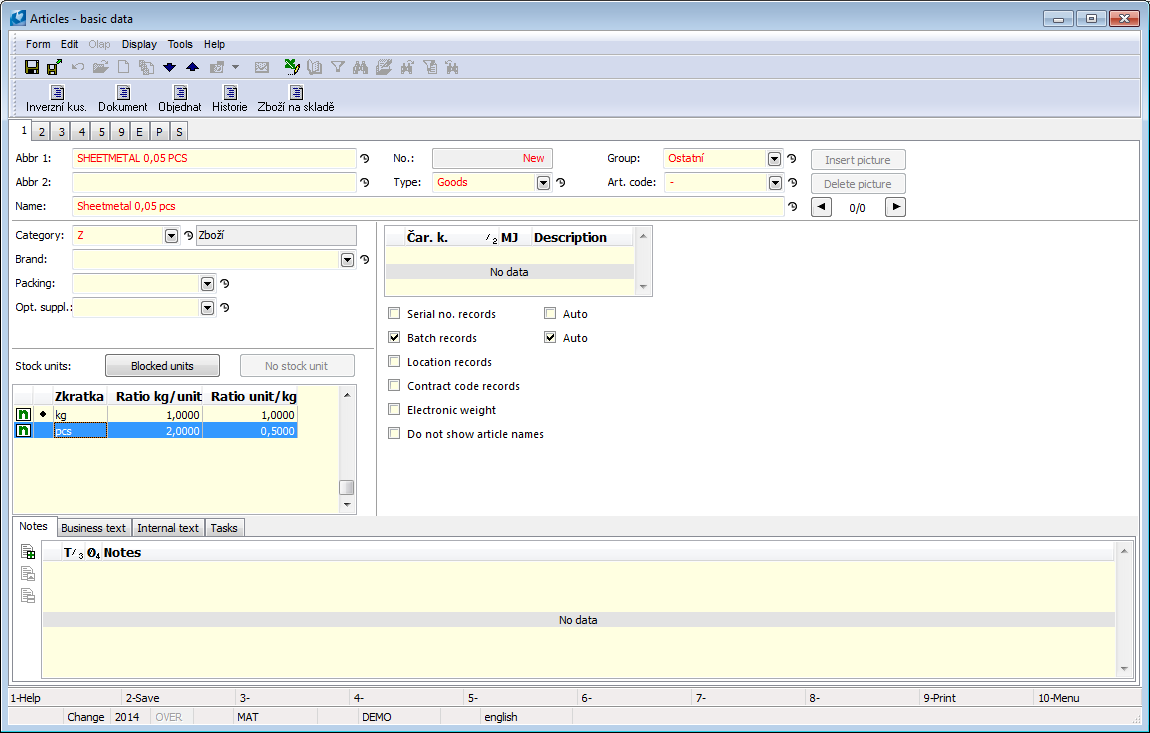
Picture: The created Article card "Sheetmetal 0,05 pcs"
Switch to the page "P" and select the "Sheet" class in the Class field.
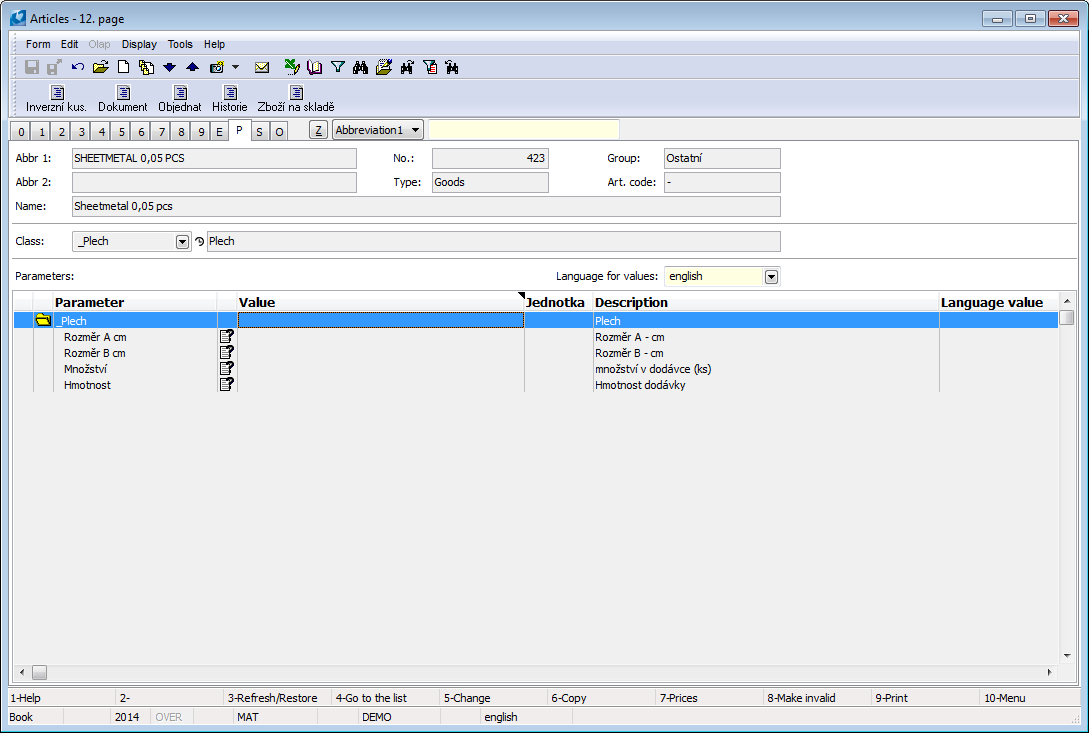
Picture: The Articles card with the assigned class "Sheet"
Example 2 - Glass:
Create an article card "Glass". As the basic stock unit, select square meters. We buy and sell in this unit. Check the Batch records and Auto fields. Fill in all required fields.
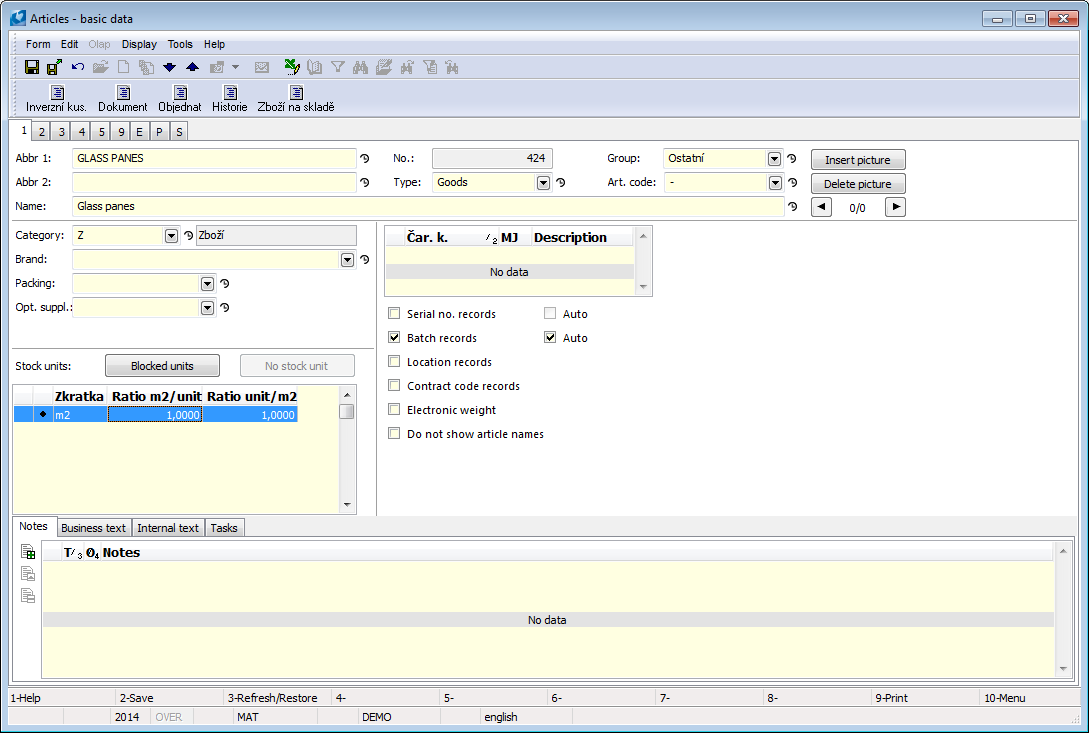
Picture: The created Article card "Glass"
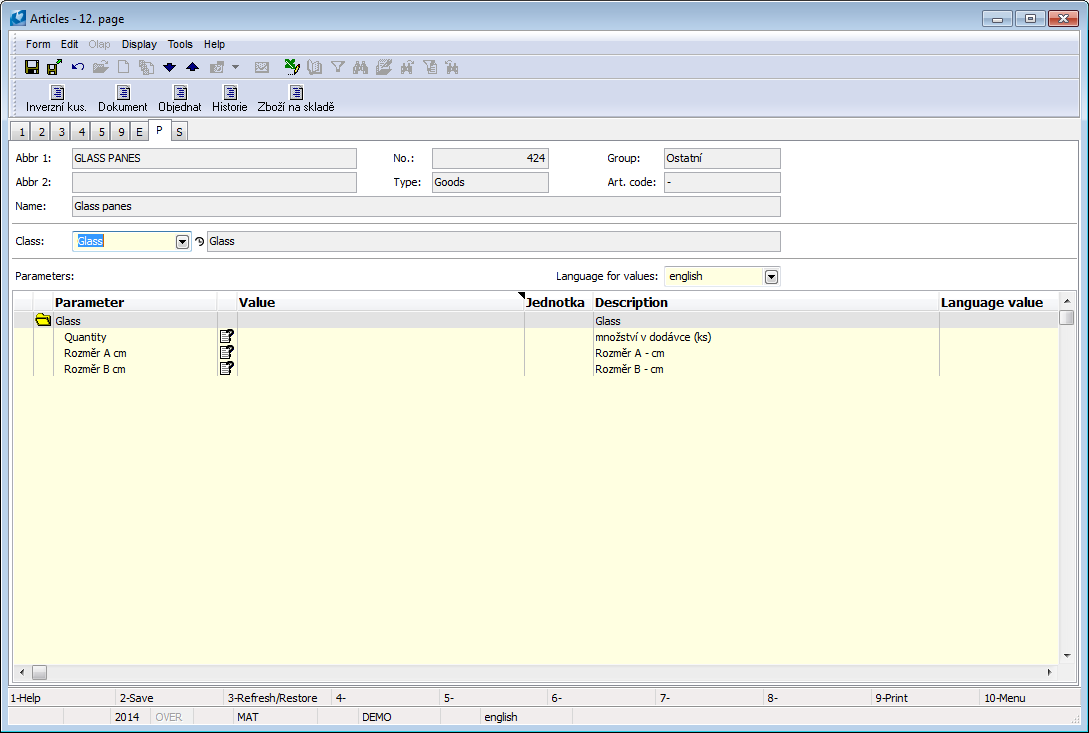
Picture: The Articles card with the assigned class "Glass"
The specified article has to have the defined Class, in that the formulas are set on the 3rd page, in order to you can work with the multidimensional quantity. The further description of individual fields of Class and Parameters is stated in the Parameters chapter in the Basic code lists and supporting modules K2 part. If at least one formula exists on the 3rd page of the Class, then program automatically checks the Multidimensional quantity support option on the 1st page of the Class form. Checkmark of this option can not be edit manually.
Example 1 - Sheetmetal
Set up a new Class "Sheet" and a group "Sheet", set up parameters for the weight of delivery, number of pieces in delivery. "Quantity" parameter will include the entered quantity in pieces. Into the "Weight" parameter, you will enter a total weight of a delivery, and into the "pcs" parameter, the calculated weight of one piece will be saved. The parameter has the same name as an alternative unit. All parameters will have the checked option Value is defined in batch or in requested parameters and Default requested parameter.

Picture: Set parameters for the "Glass" Class
Then define formulas on the 3rd page of the Class. Formula for the unit "kg" will be applied for a receipt of articles. The default unit of purchase of our articles are also kilograms, but during inserting item, you want to enter except the weight also number of pieces. Therefore this property has to be given in formula. Formula should complete calculated value into the Quantity field in Purchase item, therefore check the Valid for purchase field. The specified formula means, that the same value, which you enter by using the Quantity form into the "Weight" parameter (a content of V67 parameter in the picture), will be in the Quantity field in Purchase item.
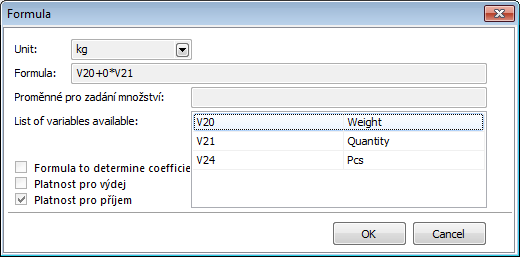
Picture: Set formulas for a receipt
Two formulas will exist for the unit "pcs". The first formula will be used in purchase and the coefficient, which should substitute a fixed set ratio from an Article card, will be counted according to it. The Formula to determine coefficient checkmark will be checked in this formula. A Formula displayed in the picture counts a coefficient as a quotient total weight and total quantity. You determine the weight of the one piece by this way. This value will be entered into the parameter of a batch when batch creation.
The second formula is used for a release (the Valid for release checkbox) and serves to ensure, that the coefficient for recalculation from a stock unit (kg) on an alternate unit (pcs) will be used. The value Quantity will be set into the sale item according to a defined formula. In your case, this value will be identical to a value, which you enter into the Quantity form (value of property V66). Before the selection of batch, the ratio from the Article card will be used for a recalculation on a basic unit, after the selection of batch, the coefficient from batch parameter will be used, and a value in an alternative unit will be preserved (value in a basic unit will be changed).
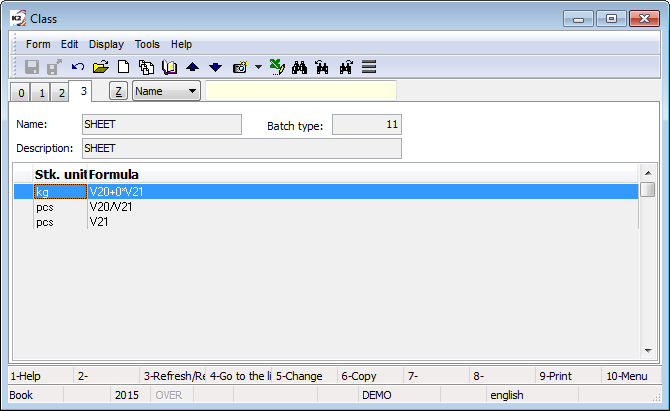
Picture: Set formulas for "Sheetmetal"
After entering formulas on the 3rd page of the Class form, the Multidimensional quantity support option is automatically checked on the 1st page of the Class form.
Example 2 - Glass
Set up new Class "Glass" and define parameters for height, weight and number of pieces in a delivery. Parameters "Dimension A" and "Dimension B" will contain height and weight, parameter "Quantity" will contain number of received pieces in the specified dimensions. All parameters will have the checked option Value from batch.
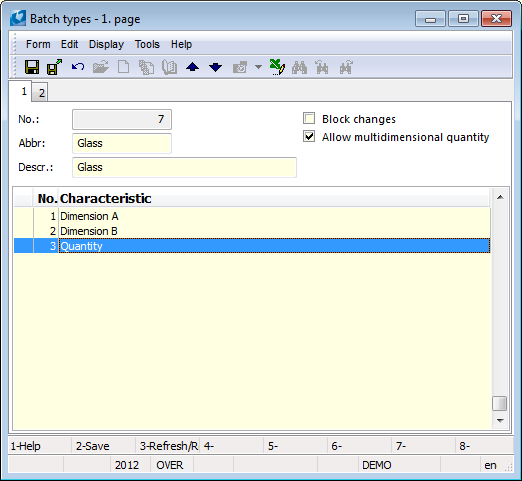
Picture: Set characteristics for the "Glass" Class
Define formulas on the 3rd page of the Class code list. In this example, you buy and sell in square meters which you calculate by multiplying of both proportions and by number of pieces. Thus, count purchase and sale according to the identical formula "Dimension A x Dimension B x Quantity". We do not need a different formula.
.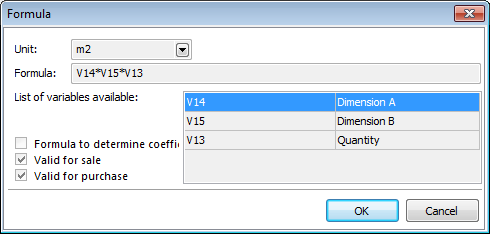
Picture: Set formula for the "Glass" Class
Purchase - Examples
Example 1 - Sheet metal
Supplier sent 100 pieces which weigh 38 kg together. We want to receive this article to a stock.
Create a Purchase order by standard procedure. Choose "Sheetmetal 0,05 pcs" article into the purchase item. The Quantity button, by which the Multidimensional quantity form will be activated (hereinafter referred to as Quantity), becomes accessible. Define required values - quantity in pieces and total weight - into this form. The result quantity that will be inserted into a Purchase items will be calculated according to the formula where the Valid for purchase field is checked and which is displayed in the upper part. If you want to insert also other parameters by this way, you would have to state them in the formula multiplied by the zero, like quantity in pieces.

Picture: Purchase item with the open Multidimensional quantity form
In the required parameters, a planned batch (i.e. batch parameters) with "Quantity-pcs" and "Weight-kg" parameters and with their content, which is identical with the values inserted in the Quantity form, will be created after specifying an item.
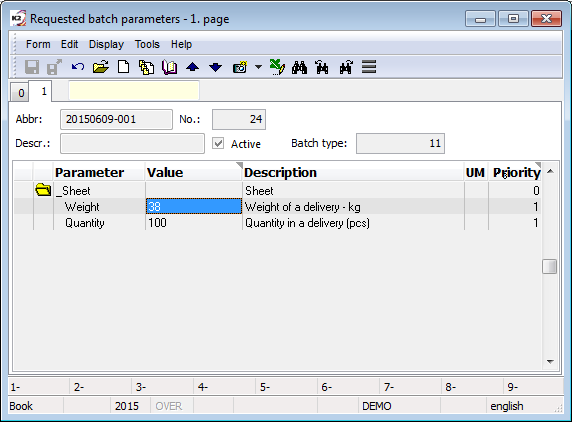
Picture: Required parameters of a planned batch
Insert an item into a receipt card (eventually the other documents that are not important for you at the moment) and confirm the receipt card. During confirmation, the batch, into which the values from the Requested parameters will be copied, is automatically created. Simultaneously, the coefficient according to the formula to determine the coefficient is calculated - in your case 1st formula "pcs" (total weight / number of pcs) - calculates and saves an average weight of one piece of this delivery. For displaying the coefficient value, It is necessary to set the "Coefficient" column.

Picture: Batch - book
So, 38 kg of sheet metal have been received to stock. Now you can sell.
Example 2 - Glass
The supplier sent 40 pcs of glass sheets with dimensions of 0.2 x 0.5 m.
Create a Purchase order by standard procedure. Choose "Glass" article into the purchase item. The Quantity button, by which the Multidimensional quantity form will be activated (hereinafter referred to as Quantity), becomes accessible. Define required values - proportion A, proportion B and number of sheets - into this form. According to the formula the resultant quantity will be calculated. This quantity will be inserted into a Purchase item. If you want to insert also other parameters by this way, you would have to state them in the formula multiplied by the zero, like in a previous example.
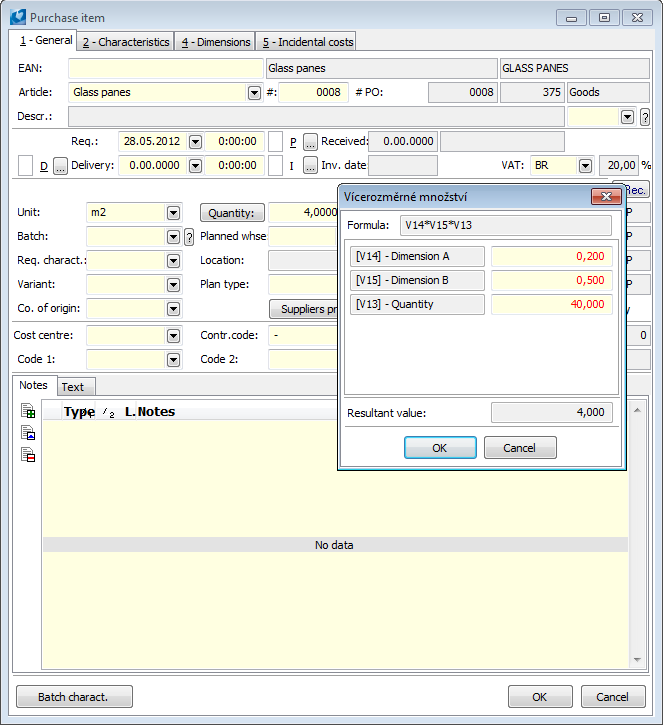
Picture: Defined dimensions and number of glass sheets in the purchase order item
In the required parameters, a planned batch (i. e. required parameters) with the "Dimension A", "Dimension B" and the "Quantity" parameters with a content, that is identical with the values inserted in the Quantity form, will be created after specifying an item. Insert the item into a receipt card (or other documents, that are not important for you at the moment) and confirm the receipt card. The batch, into which the values from the Requested parameters will be copied, is automatically created when confirmation.
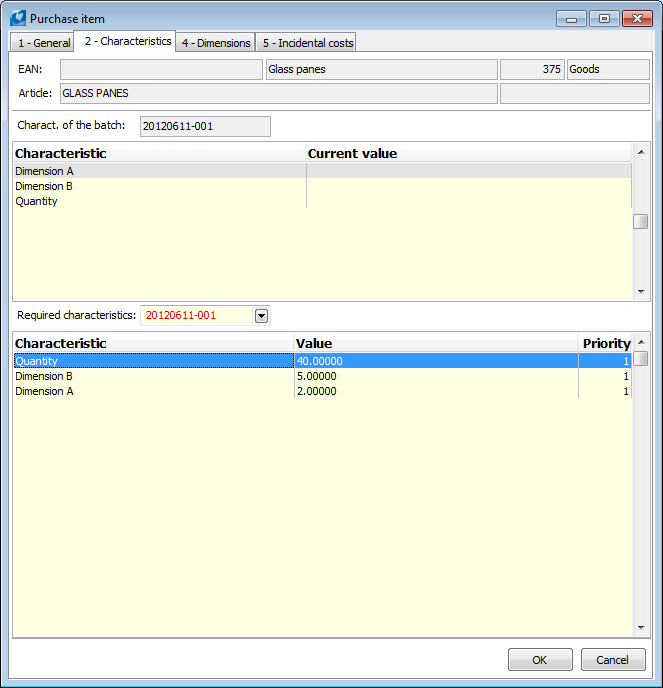
Picture: The parameters of automatically created batch on a receipt card
So, 40 pcs of glass sheets with dimensions of 0.2 x 0.5 m have been received to stock. Disposal in the Articles book has increased by 4 square meters.
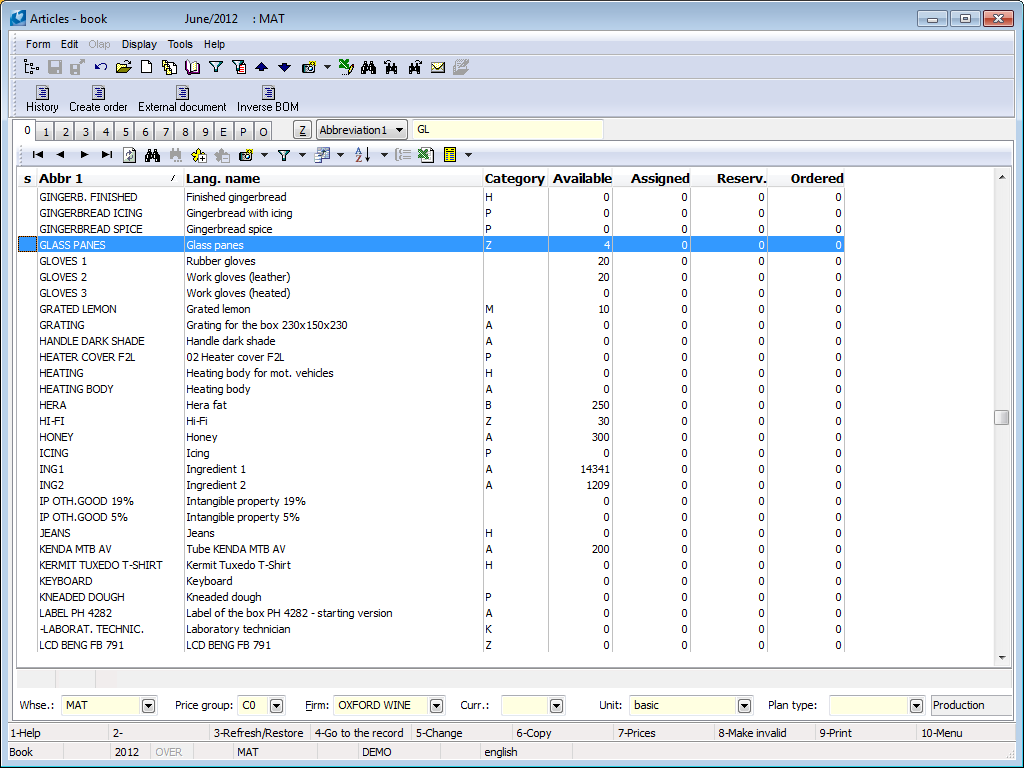
Picture: Increased disposal of the "Glass" article
Sale
Example 1 - Sheet metal
A customer wants to buy 40 pcs of a "Sheetmetal 0,05 pcs" article and he wants to know the price. You want to sell the sheetmetal for a price 5.85 EUR/kg always in whole pieces, so as to the price corresponds to a specific sheetmetal according to its weight.
In an Article card, set a selling price at 5.85 EUR. Detailed information about how to set selling prices are stated in the Price Creation methodology in K2 IS chapter.
Create a standard Sales order as you are used to. Choose "Sheetmetal 0,05 pcs" article into the Sales items. It makes the button Quantity, by which you open the Quantity form, accessible. In this form define only the "Quantity" value (it means a count of pieces which you want to sell), because this one property is specified in formula with a validity for a sale.
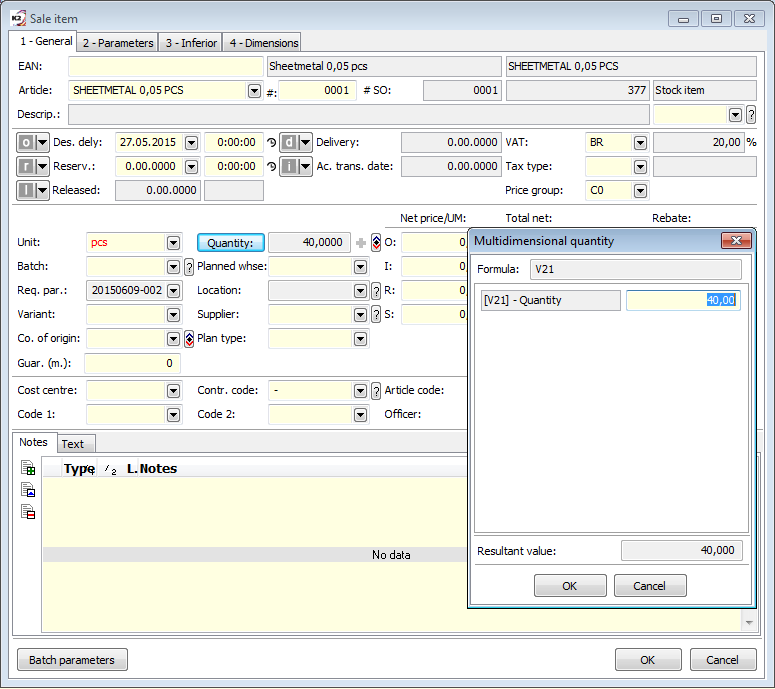
Picture: Sale item with the open Multidimensional quantity form
The entered quantity will be automatically inserted into Quantity in the Sale item too, because you have set the default sale unit of this Article card on "pcs". As long as a batch is not selected, a recalculation on the kilograms will execute according to a proportion which is set in alternate unit on the Article card. Price 70.20 EUR (it means 1.755 EUR/pcs, it is 5,85 EUR/kg) is only a preliminary price and it does not correspond to the concrete delivery.
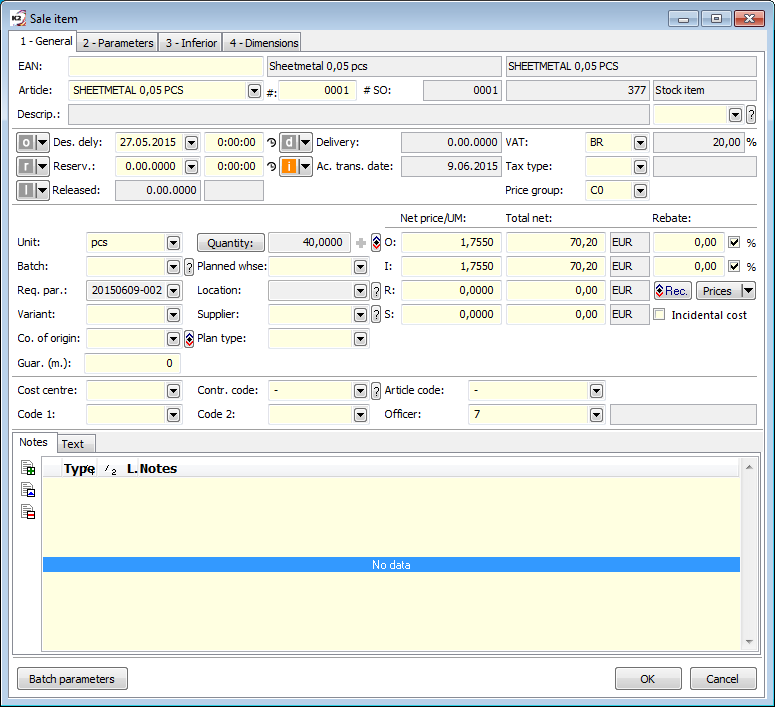
Picture: Sale item - an alternate unit "pcs"
If you change alternate unit on "kg", you will see a quantity 12 kg.
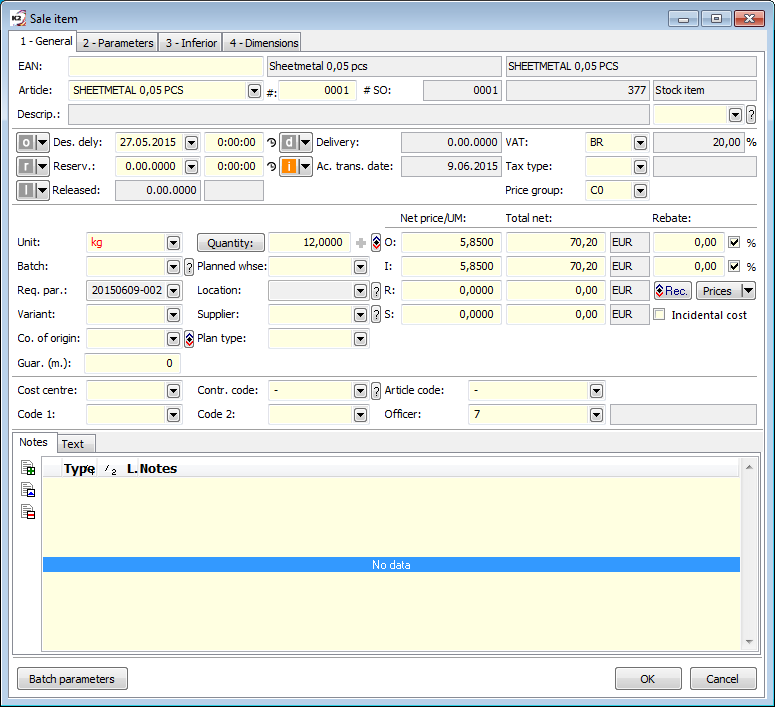
Picture: Sale item - "pcs" unit
Change unit on the pieces backward.
You have to choose a batch for the specification of a price. The "pcs" parameter will be used for an exact calculation of the weight of required 40 pcs. The price will also be changed on 2.223 EUR per piece after the selection of a batch. This price is exact.
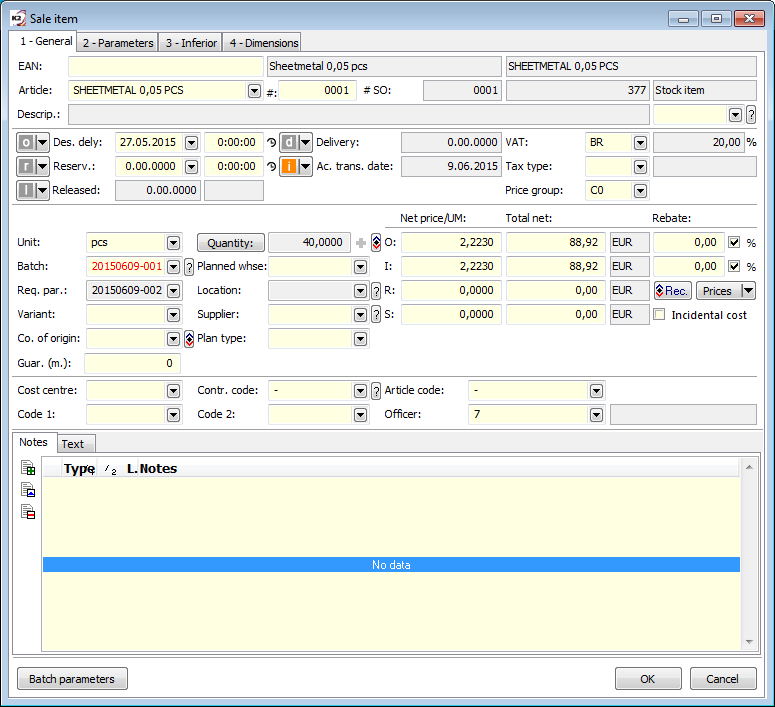
Picture: Sale item with a selected batch
If you change the unit on "kg" now, 15.2 kg will be displayed, because the selected batch weighs 0.38 kg/pcs against 0.3 kg/pcs in ratio for the alternate unit.
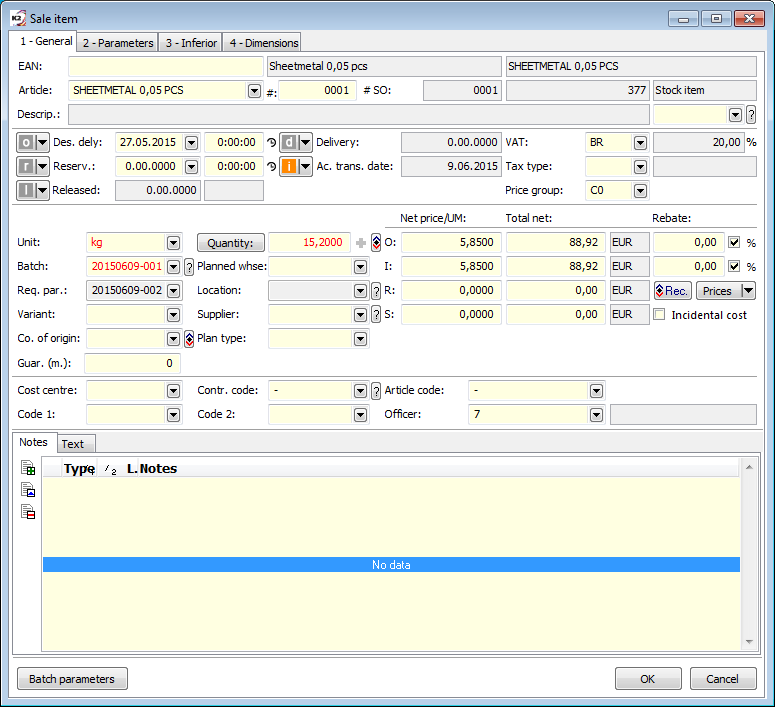
Picture: Sale item with a selected batch and with an altered unit on "kg"
After confirmation a created release note, the availability of "Sheetmetal 0,05 pcs" article will be decreased on 22.8 kg.
Attention! A batch in a release has to always be selected manually, auto-completion batch does not work here. An item could be divided and thereby the data will be damaged, because the values about a quantity are saved in the parameters, which are also copied into a newly automatically created item!
Example 2 - Glass
A customer wants to buy 30 pcs of glass sheets with proportions of 0,2 x 0,5 m and he agrees with the price 10 GBP per square meter.
Create a standard Sales order as you are used to. Choose "Glass" article into the Sale item. It makes the button Quantity, by which you open the Quantity form, accessible. Enter a required proportions and quantity in this form. Calculated area (according to a formula for sale) will automatically entered to the Quantity field on the Sale item.

Picture: Sale item - "m2" unit
Create a release note. 3 square meters will be displaced to the Assigned column from the Available column in the Article book. Select an appropriate batch on the basis of required parameters (proportions and count). Now you can confirm a Release Note. Released quantity will be deducted from the Assigned column. One square meter will remain on the stock.
Attention: If you undo confirm an older stock document and meanwhile the formula was changed, it will not be impossible to confirm the document again because of the change of algorithm calculation! In this case, it is necessary to delete a batch and required parameter too and by using the Multidimensionally quantity form enter the values again and so create a new required parameter and by confirmation of the document create also a new batch according to a new formula.